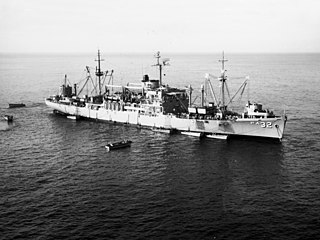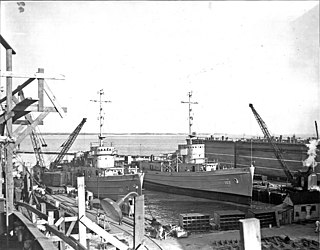
USS Salish (ATA-187) was a Sotoyomo-class rescue tug of the US Navy. Her hull was laid down on 29 August 1944. She left US service on 10 February 1972 and was recommissioned in the Argentine Navy on the same day as the ARA Alférez Sobral (A-9).

USS Capricornus (AKA-57/LKA-57) was an Andromeda-class attack cargo ship named after the zodiacal constellation Capricornus.

USS Calvert (APA-32) was a Crescent City-class attack transport that served with the United States Navy during World War II and the Korean War. In addition to her ten battle stars, Calvert was awarded a Navy Unit Commendation.

USS Quapaw (ATF–110/AT-110) was a Abnaki-class fleet ocean tug in the United States Navy. She was named after the Quapaw.

USS Rail (AM-26/AT-139/ATO-139) was a Lapwing-class minesweeper built for the United States Navy during World War I. She was the first U.S. Navy ship named for the rail, a small wading bird, related to the cranes.
USS Saunter (AM-295) was an Admirable-class minesweeper built for the U.S. Navy during World War II. She was built to clear minefields in offshore waters.
USS Scout (AM-296) was an Admirable-class minesweeper built for the United States Navy during World War II; she was the third U.S. Navy ship to bear the name. She was awarded 5 battle stars for service in the Pacific during World War II. She was decommissioned in February 1947 and placed in reserve. Although she did not see service in the war zone, Scout was recommissioned in May 1951 during the Korean War and remained in commission until March 1954, when she was placed in reserve again. While she remained in reserve, Scout was reclassified as MSF-296 in February 1955 but never reactivated. In October 1962, she was sold to the Mexican Navy and renamed ARM DM-09. Although she is reported out of service, her ultimate fate is not reported in secondary sources.

USS Chickasaw (AT-83/ATF-83) was a Navajo-class fleet tug constructed for the United States Navy during World War II. She served in the Pacific Ocean in World War II and the Korean War, and was awarded six battle stars for World War II and two battle stars during the Korean War.

USS Grapple (ARS-7) is a Diver-class rescue and salvage ship commissioned in the United States Navy from 1943 to 1946 and from 1951 to 1977. In 1977, she was sold to Taiwan and was renamed ROCS Da Hu (ARS-552).

USS Preserver (ARS-8) was a Diver-class rescue and salvage ship commissioned by the U.S. Navy for service in World War II. She was responsible for coming to the aid of stricken vessels.

USS Grasp (ARS-24) was a Diver-class rescue and salvage ship commissioned by the U.S. Navy during World War II. Her task was to come to the aid of stricken vessels.

USS Safeguard (ARS-25) was a Diver-class rescue and salvage ship in service with the United States Navy from 1944 to 1947 and from 1952 to 1979. She was then transferred to Turkey where she served as TCG Işın (A-589) until 2017.

USS Conserver (ARS-39) was a Bolster-class rescue and salvage ship acquired by the U.S. Navy during World War II. Her task was to come to the aid of stricken vessels.

USS Hoist (ARS-40) was a Bolster-class rescue and salvage ship acquired by the United States Navy during World War II. Its task was to come to the aid of stricken vessels.

USS Opportune (ARS-41) was a Bolster-class rescue and salvage ship acquired by the U.S. Navy during World War II. Her task was to come to the aid of stricken vessels.
USS Satinleaf (AN-43/YN-62) was an Ailanthus-class net laying ship which served with the U.S. Navy in the western Pacific Ocean theatre of operations during World War II. Her career was without major incident, and she returned home safely after the war with two battle stars to her credit.

USS Teak (AN-35/YN-30) was an Aloe-class net laying ship which served with the U.S. Navy in the Pacific Ocean theatre of operations during World War II. She was assigned to serve the U.S. Pacific Fleet with her protective anti-submarine nets and earned two battle stars and other commendations for her bravery.

USS Apache (AT-67/ATF-67) was a Navajo-class fleet tug, later fleet ocean tug, in commission in the United States Navy from 1942 to 1946 and from 1951 to 1974. She saw service in World War II, the Korean War, and the Vietnam War.
USS Sonoma (ATA-175) was a tugboat of the United States Navy, which served during World War II. She was the third Navy ship to bear the name "Sonoma", which is of American-Indian origin, in accordance with the Navy's naming convention for tugs.

USS Hidatsa (ATF-102) was Abnaki-class tugboat during the World War II. The ship was later sold to Colombia as ARC Rodrigo de Bastidas (RM-74). Her namesake is an Indian group of the Sioux Tribe of North Dakota, now living on the Fort Berthold Reservation.















